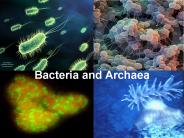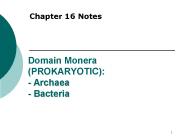Archaea PowerPoint PPT Presentations
All Time
Recommended
Title: Author: skyjx Last modified by: wsw Created Date: 6/5/2000 12:03:43 PM Document presentation format: Company
| PowerPoint PPT presentation | free to view
Archaea Resemble bacteria superficially but may be more closely related to eukaryotes than bacteria May be heterotrophs or autotrophs Methanogens
| PowerPoint PPT presentation | free to download
Prior to 1977 they were considered bacteria ... Facultative and Obligate Anaerobes and Aerobes. How do Archaea tolerate the heat? ...
| PowerPoint PPT presentation | free to download
Archaea Extremophiles Evolutionarily Primitive Formerly known as Archaeabacteria
| PowerPoint PPT presentation | free to view
Archaea. Resemble bacteria superficially but may be more closely related to ... Some forms live symbiotically with corals, anemones, jellyfish, giant clams, sponges ...
| PowerPoint PPT presentation | free to download
Gradua o em Biotecnologia Disciplina de Biotecnologia Microbiana II Archaea: Bact rias pr -hist ricas? Prof. Fabricio Rochedo Concei o fabricio.rochedo@ufpel ...
| PowerPoint PPT presentation | free to download
Example genera. Characteristics. Physiological Group. Phylum. Summary of Archaeal Groups 2 ... Euryarchaeota. Example genera. Characteristics. Physiological ...
| PowerPoint PPT presentation | free to view
Cell WallThe cell wall of bacteria protects the cell from osmostic shock and physical damage. In addition, it also confers rigiditiy and shape of bacterial cells.
| PowerPoint PPT presentation | free to download
Clone libraries of 16S rDNA were also generated in order to validate array results. ... detected in clone library and array = detected by array only = present ...
| PowerPoint PPT presentation | free to download
Bacteria and Archaea CHAPTER 27 Note: Students should review Figure 20.4: Cloning Genes in Bacterial Plasmids Students should review Figure 20.25: Using the Ti ...
| PowerPoint PPT presentation | free to download
Cleaning Up Bioremediation 5. Making Medicines 4. In Your Food ... Sac Fungi 2. Club Fungi 1. Threadlike Fungi Club Fungi Threadlike Fungi 3 Main Types of Fungi ...
| PowerPoint PPT presentation | free to download
Thermal vents at bottom of ocean. extreme salt conditions (Great Salt Lake, Dead Sea) ... Brightly colored due to purple pigments (bacteriorhodopsin) ...
| PowerPoint PPT presentation | free to view
No free molecular oxygen existed for the first 2.3 billion years of ... Molecular ... Evaluating Molecular Phylogenies. Major Clades of Bacteria ...
| PowerPoint PPT presentation | free to view
Ch. 27: Bacteria and Archaea Modern/regular/eubacteria and the ancient methanogens Prokaryote cells with cell membranes, cytoplasm/cytosol, DNA in the form of one ...
| PowerPoint PPT presentation | free to view
Some prokaryotes form endospores that enable them to survive harsh conditions. ... (vinegar, pickles, sauerkraut, olives, yogurt, cheese) ...
| PowerPoint PPT presentation | free to view
Ch. 27: Bacteria and Archaea Modern/regular/eubacteria and the ancient methanogens Prokaryote cells with cell membranes, cytoplasm/cytosol, DNA in the form of one ...
| PowerPoint PPT presentation | free to view
using fluorescent probe for specific DNA sequences ... accumulation of high level of Mn 2. DNA toroid. Photosynthetic Bacteria ...
| PowerPoint PPT presentation | free to view
... Bacteria ( formerly Eubacteria) Eucarya (plants, animals, protista, fungi) ... Genetics Half size of bacterial genomes 1900 KB vs 4700 KB (E coli) ...
| PowerPoint PPT presentation | free to download
Chapter 16 Notes Domain Monera (PROKARYOTIC): - Archaea - Bacteria Evolution/Classification Bacteria are the most numerous and most ancient species on Earth Evolution ...
| PowerPoint PPT presentation | free to download
Mitochondria. Meiosis and sex. Plastids. Shared by all eukaryotes. Only some. eukaryotes ... mitochondrion. cyanobacterium. Eukaryote. nucleus. plastid ...
| PowerPoint PPT presentation | free to view
Title: PowerPoint Presentation Author: Carl Castles Last modified by: Information Technology Created Date: 6/30/2004 7:16:44 PM Document presentation format
| PowerPoint PPT presentation | free to view
Title: The Prokaryotes: Domains: Bacteria Archaea Author: Administrator Last modified by: Lisa Created Date: 4/13/2005 5:46:05 PM Document presentation format
| PowerPoint PPT presentation | free to view
Bacteria and Archaea and Protists Chapter 27 Sections 27.1-27.6 Chapter 28 Sections 28.1 and 28.7 Morphology Cocci Bacilli Spirilla Cell Wall What are the functions ...
| PowerPoint PPT presentation | free to view
Biologists now categorize all life into three domains: ... They have DNA that encodes polypeptides. ... They can survive extreme alkalinity and saltiness. ...
| PowerPoint PPT presentation | free to view
Title: Table of Contents Author: Wendy Beck Last modified by: Michael Moon Created Date: 10/16/2000 7:08:56 PM Document presentation format: On-screen Show
| PowerPoint PPT presentation | free to view
This is based on direct comparison to known taxonomic groups. ... bacterium (Escherichia coli), an archaean (Methanococcus vannielii), and a ...
| PowerPoint PPT presentation | free to view
Show videos. 26.2 Where Are Prokaryotes Found? ... Gram-negative bacteria retain the red dye. ... of crabs, mollusks, and giant tube worms, at depths of 2,500 ...
| PowerPoint PPT presentation | free to view
Domain Eukarya: Kingdom Protista, Kingdom Fungi, Kingdom Plantae, Kingdom Animalia ... no nucleus, membrane-bound organelles, or cytoskeleton. Characteristics ...
| PowerPoint PPT presentation | free to view
Only organisms of the domains Bacteria and Archaea consist of prokaryotic cells. Protists, fungi, animals, and plants all consist of eukaryotic cells.
| PowerPoint PPT presentation | free to download
... PUBLIC '-//Apple Computer//DTD PLIST 1.0//EN' 'http://www.apple.com/DTDs/PropertyList-1.0.dtd' ... xmlns:stRef='http://ns.adobe.com/xap/1.0/sType/ResourceRef ...
| PowerPoint PPT presentation | free to view
basal rings and rod. stiff helical flagellum. is rotated by 'motor apparatus' ... Yellowstone Hot Spring. Optimum temperature 85 C. Stability of macromolecules ...
| PowerPoint PPT presentation | free to download
Study Hints: This is a detailed and technical section! From these lecture notes and your text: ... Pasteurella: septicemia and 'cholera' of domestic animals and fowl ...
| PowerPoint PPT presentation | free to view
Chapter 11. The Prokaryotes: Domains of Bacteria and Archaea. Selected general from Bergey's Manual ... Nonproteobacteria Gram Negative. Cyanobacteria. Anabena ...
| PowerPoint PPT presentation | free to view
Survey of Microbes Part I: Important prokaryotes Gram negative organisms, archaea, and others IMPORTANT GRAM NEGATIVE PROTEOBACTERIA G- cocci Neisseria: _____ N ...
| PowerPoint PPT presentation | free to view
histones-like proteins associated with the DNA. No true ... Transcription Factor IIB. TATA-binding protein (TBP) Translation machinery. initiation factors ...
| PowerPoint PPT presentation | free to view
Cat-scratch disease. Brucella non-motile coccobacilli. Brucellosis ... R. rickettsii - Rocky Mountain Spotted Fever (ticks) The (alpha) Proteobacteria ...
| PowerPoint PPT presentation | free to view
Lane 4: DNA Molecular Weight Marker II (Roche 236250) Lane 5: DSM 13279, Collinsella stercoris ... Molecular Weight Marker II (Roche 236250) Lane 14: c( -Marker) ...
| PowerPoint PPT presentation | free to view
Title: Survey of Microbes Part I: Important prokaryotes Author: Dana Nayduch Last modified by: LONNIE Created Date: 9/13/2005 1:44:04 AM Document presentation format
| PowerPoint PPT presentation | free to view
Cell wall without peptidoglycan. histones-like proteins associated with the DNA. ... Wall black smokers, hydrothermal vents. Coccoid-shaped, Cell wall: protein. Obl. ...
| PowerPoint PPT presentation | free to view
Isolation of an autotrophic ammonia-oxidizing marine archaeon2 ... Nitrification. FISH. Fluorescence in situ hybridization. Filter or preparation ...
| PowerPoint PPT presentation | free to view
Bacilli. Spirilla. Cell Wall. What are the functions of the cell wall in prokaryotes? ... Endospore forming bacteria Bacillus. Mycoplasmas- smallest bacteria, ...
| PowerPoint PPT presentation | free to view
3. Using a diagram, distinguish among the three most common shapes of prokaryotes. ... Gram stain a stain used to distinguish two groups of bacteria by virtue of a ...
| PowerPoint PPT presentation | free to view
A population of spherical cells with a diameter of 1 ... a. bacillus. b. coccus. c. spirillum. d. filamentous. BACK TO GAME. Topic 2: Prokaryotic Cell Walls ...
| PowerPoint PPT presentation | free to view
Rob Edwards, Jonathan A. Eisen, Ross ... Tapping into prokaryotic biodiversity - Industrial Biotechnology ... Current Opinion in Biotechnology, 15:280 284 ...
| PowerPoint PPT presentation | free to view
Title: PowerPoint Presentation Author: Microbial Ecology Last modified by: Bolhuis Created Date: 10/1/2002 2:47:47 PM Document presentation format
| PowerPoint PPT presentation | free to view
Methanogenic archaea under permafrost extreme conditions: a model for putative life on Mars ... Martian Conditions. Physiological Potential of Methanogenic Archaea ...
| PowerPoint PPT presentation | free to view
Methanogenic archaea utilize a specific pathway in their metabolism, converting ... Methyl-coenzyme M reductase (MCR) catalyzes the key step in the process, namely ...
| PowerPoint PPT presentation | free to view
a)Normal FISH without ultrasound treated. b)Normal FISH without agrose added ... d)CARD-FISH without ultrasound treated. e)Normal FISH treated with all procedures ...
| PowerPoint PPT presentation | free to view
Bacteria Archaea Common ancestor of all species living today Eukarya
| PowerPoint PPT presentation | free to view
TBRC microbiome market report includes segments bacteria, archaea, viruses, other microbiomes, therapeutics, diagnostics, infectious diseases http://bit.ly/3EmHUS5
| PowerPoint PPT presentation | free to download
Day 12 What is the main difference between the Domain Eukarya and the Domains Archaea and Bacteria? Archaea & Bacteria don't have a nucleus. Eukarya do.
| PowerPoint PPT presentation | free to download
Kingdoms and Domains Kingdoms and Domains Bacteria Archaea Eukarya Bacteria Archaea Protista Plantae Fungi Animalia Monera Protista Plantae Fungi Animalia The three ...
| PowerPoint PPT presentation | free to download
Chapter 17 - 17.3 Domains and Kingdoms * * Domains There are 3 domains Eukarya Archaea Bacteria * Kingdoms There are 6 kingdoms in the 3 domains Archaea Bacteria ...
| PowerPoint PPT presentation | free to download
Living organisms are classified into 3 Domains 1. Bacteria 2. Archaea 3. Eukarya 4 Kingdoms in this Domain
| PowerPoint PPT presentation | free to view
Live as unicellular organisms, but sometimes in groups. ... Archaea are Extremophiles: live well in heat, salt, low oxygen. Archaea ...
| PowerPoint PPT presentation | free to view
The Hidden World of Microbes 1) Virus / Viroid / Prion non-living 2) Bacteria 3) Archaea 4) Protists 3 domains
| PowerPoint PPT presentation | free to download
























































